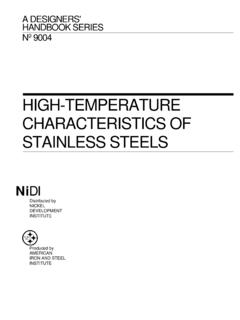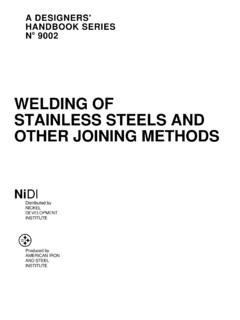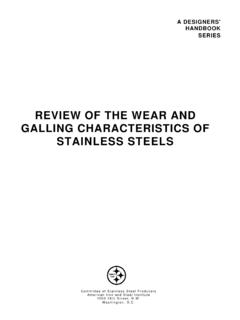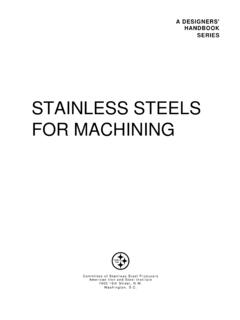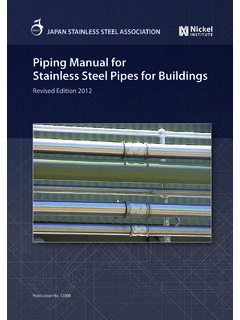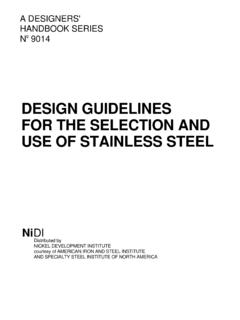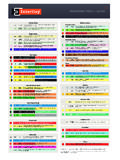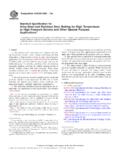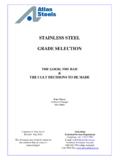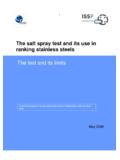Transcription of HIGH-TEMPERATURE CHARACTERISTICS OF …
1 A DESIGNERS'. HANDBOOK SERIES. No 9004. HIGH-TEMPERATURE . CHARACTERISTICS OF. stainless STEELS. NiDI. Distributed by NICKEL. DEVELOPMENT. INSTITUTE. Produced by AMERICAN. IRON AND steel . INSTITUTE. CONTENTS. Introduction .. 4. HIGH-TEMPERATURE Design Factors .. 4. Service Life .. 4. Allowable 4. 4. 4. Criteria for Selection .. 5. Short-Time Tensile Properties .. 5. Creep .. 5. Creep-Rupture .. 8. Thermal Stability .. 12. HIGH-TEMPERATURE stainless Steels .. 14. H 14. The information and data presented N 15. in this booklet are typical or average Physical Properties .. 16. values and are not a guarantee of Corrosion Resistance at Elevated maximum or minimum values. temperatures .. 18. Materials specifically suggested for 18. applications described herein are Sulfidation .. 21. made solely for the purpose of 24. illustration to enable the reader to Hydrogen Attack .. 24. make his own evaluation. While the Ammonia (and Nitrogen).. 25. information is believed to be 25.
2 Technically correct, neither American Liquid 26. Iron and steel Institute, its Committee Molten Salts .. 28. of stainless steel Producers nor the Fuel 30. companies represented on the Automotive Exhaust .. 30. Committee warrant its suitability for 31. any general or particular use. Tables .. 32. 3. INTRODUCTION HIGH-TEMPERATURE DESIGN amount of deformation that can be Developments in pollution control, FACTORS permitted during the total service life. nuclear power, solar energy, coal There are four design factors that This factor determines which of two gasification, gas turbines, and in all engineers consider when choosing HIGH-TEMPERATURE strength properties phases of industrial production involved materials for service at elevated should be given priority; creep or with HIGH-TEMPERATURE service are temperature. These design factors are: creep-rupture (sometimes called stress- causing designers to more-closely 1. Service life rupture). If the component is small and/or examine the elevated-temperature 2.
3 Allowable deformation the tolerances very close, such as in properties of construction materials. As 3. Environment turbine blades, creep is regarded as the new processes are commercialized, and 4. Cost. overriding factor. But if the component is as production capacities in existing large and capable of accommodating facilities are increased, temperature Service Life greater deformation, such as shell-and- often becomes an important The design service-life requirement tube heat exchangers, the creep rupture consideration in the selection of of any given component or piece of strength is the usual basis for selection. materials. equipment can vary from seconds in Where considerable deformation is stainless steels are generally selected, certain aerospace applications, such as permitted, it is well to know the first, on the basis of their resistance to rocket engines, to 25 or more years for anticipated time to rupture, so parts can corrosion and, second, on the basis of power plant condenser tubes.
4 Between be scheduled for replacement before their mechanical properties. As the these extremes are other more-moderate failure occurs. It is also useful to know temperatures of operating environments service-life requirements, such as those whether or not service at elevated increase, however, elevated-temperature in chemical, petrochemical, or petroleum temperature is cyclic or continuous. properties quickly become the primary processing, where process design Cyclic operation may lead to failure by concern. The family of stainless steels is changes are more likely to occur at 10- fatigue or loss of metal due to flaking of most versatile in its ability to meet the to 15-year intervals. the oxide scale prior to the expected requirements of HIGH-TEMPERATURE Life expectancy may also vary from creep-rupture time. service. company to company within any given A discussion of the mechanical strength This booklet discusses factors that industry. For example, in thermal- properties of stainless steels should be considered by engineers cracking stills in the petroleum industry, at elevated temperatures begins on facing problems in designing equipment some plants have standardized on Type page 5.
5 For HIGH-TEMPERATURE service. The 304 stainless steel , whereas, other plants CHARACTERISTICS that make some of the with similar equipment and operating Environment stainless steels particularly useful in conditions use chromium-molybdenum The effect of exposure of a material to HIGH-TEMPERATURE environments are steels with lower alloy contents. Naturally, media can be a very complex subject. described, and typical engineering data the latter materials will not last as long as Elevated temperatures tend to increase are presented. Also discussed, but as a the former, but that is part of the design corrosive action, heat transfer may affect secondary consideration, are the plan for those plants; , low-cost corrosivity, thermal cycling can increase corrosion-resistance qualities of stainless materials but more frequent replacement metal wastage through spalling of steels at elevated temperatures . versus more-expensive materials having protective scale on the metal surface, and It should be noted that the material longer service life.
6 Metal temperature probably will not be presented in this booklet is intended as For a given type of steel at a specific the same as the environment to which it general information; for design purposes thickness, the expected service life is exposed. Generally, if oxidation or it is recommended that reference be depends on the maximum temperature to other forms of scaling are expected to be made to appropriate standards and which it is exposed plus the maximum severe, a greater cross-sectional area . specifications, such as those prepared stresses to which it is subjected, also beyond that indicated by mechanical- by the American Society of Mechanical whether service is at a constant property requirements is usually Engineers (ASME) and the American temperature or at intermittently high specified. Problems like this cannot be Society for Testing and Materials (ASTM). temperature. solved by laboratory analysis. It requires For a prolonged service life, such as 20 observation of test specimens in actual years, plain carbon steels are usually operating environments in pilot plants or limited to a maximum operating full-size units.
7 Temperature of 750 F (399 C); the % A discussion of the corrosion behavior molybdenum alloy steels to of stainless steels in various high - approximately 850 F (454 C); and the temperature environments begins on stainless steels to considerably higher page 18. temperatures depending upon the type used. It is important to recognize that for Cost HIGH-TEMPERATURE service, strength at The consideration of cost in selecting temperature is related to time at materials for HIGH-TEMPERATURE service temperature. must reflect not only the initial cost of the equipment but the cost of replacement Allowable Deformation and downtime as well. Designers should Another factor to consider in designing not rule out the more highly alloyed, for HIGH-TEMPERATURE service is the more-costly materials if a premature 4. failure could result in shutting down the strengths than the martensitic or ferritic tempered condition can be seen. entire plant and loss of valuable (400 Series) grades.
8 The precipitation (Short-time tensile data on eight AISI- production. Designers should consider hardening grades show considerably numbered stainless steels frequently the possibility of using different steels higher hot strengths at lower temper- used for HIGH-TEMPERATURE service are within the same application. For example, atures, but their strength advantage presented in the tables beginning on in tubular recuperators for preheating disappears quickly as they begin to page 32.). ingot soaking pit air, the combustion gas overage. passes through tubes composed of The strengthening of stainless steels by Creep lengths of Type 446, Type 430, and 5% cold working or heat treatment can be Over about 900 F (482 C), deformation chromium steel welded together. The beneficial in the temperature range under stress is plastic rather than elastic, combustion gas enters the Type 446 where the steels behave in an elastic so the yield point as determined by the stainless steel end of the tube at 1600 F manner (up to about 900 F (482 C)).
9 At short-time tensile test is higher than the (871 C) and exits the 5% chromium steel higher temperatures this advantage is creep or stress-rupture strength. end of the tube at 800 F (427 C). lost, as illustrated by the charts in Figures Therefore, in structures operating at 2 and 3. Figure 2 shows the effect of cold temperatures above 900 F (482 C), time CRITERIA FOR SELECTION work on the short-time tensile properties becomes a major factor in determining Once the design parameters have been of Type 301, and in Figure 3, which safe loading stresses, since the stress established, the engineer may then shows typical short-time tensile strengths which will cause failure or a maximum evaluate the materials that appear to be of various stainless steels, the advantage permissible elongation decreases capable of meeting the design strength of using Type 410 in the quenched-and- directly as the time during which the requirements. For service at elevated temperatures , the first factor to be considered is hot strength, as this is Figure 1.
10 Decisive in determining the deformation Hot-Strength CHARACTERISTICS (1). over the expected life. Thermal stability is second, since this may set limits to a particular type from the standpoint of softening or, more commonly, embrittlement. Physical properties may also be significant in certain cases. Short-Time Tensile Properties Up to a temperature of about 900 F. (482 C), the short-time tensile properties are most important. These are property values that can be used where parts are not exposed to high service temperatures for extended periods of time. The standard tests for these properties are conducted after the test specimens have been held at a temperature only long enough to insure uniform temperature throughout . normally about 30 minutes. The data do not reflect any effect of long-time exposure to high temperatures . The special techniques involved in performing the tension test at elevated temperatures are covered by ASTM. Specifications E21 and E151.
